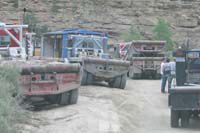| Gas field crews congest the road in Cottonwood Canyon during recent operations. The roads in and around Nine Mile Canyon can be congested with heavy industrial traffic. Conservation groups have complained of the situation and possible damage to archaic rock writing on the walls of the canyon from the dust produced by the traffic. Officials from the county and private corporations have tried to take measures to reduce the dust. |
Despite a few setbacks, Bill Barrett Corporation has been drilling in the Tavaputs Plateau and has hit a milestone in gas production in the past few months.
“Our company hit a 100 million cubic feet of production per day from the wells in the plateau recently,” noted Jim Felton, the company’s investor relations manager, during last week’s Carbon County Commission meeting. “And once all the facilities to transport the gas are in, we could go up to about 140 million cubic feet per day in the next year.”
Barrett has been working in the Tavaputs Plateau for four years. The company started with exploratory wells, then completed some seismic testing and finally moved to a full production program.
Felton said the area near Nine Mile Canyon has 60 to 70 operating wells at the present time.
“This next year, we will be looking at drilling about 30 more shallow wells and about five deep wells,” explained the Barrett representative. “The deep wells are obviously much more expensive to drill.”
Deep gas well production has primarily been pioneered in the Carbon County gas fields.
A deep well can go down as far as 18,000 feet at a cost of $1,000 per foot.
In general, shallow wells cost between $2 to $3 million to drill.
Deep well drilling costs can range between $7 and $10 million.
“Our experience has been that the wells we have on Peters Point have been more productive than the wells in Prickly Pear Canyon,” remarked Felton. “We continue to improve our techniques in drilling and removing gas in both those areas.”
Last year Oil and Gas Investor Magazine, an international trade publication, named Barrett Corporation’s deep test well in the plateau the 2005 discovery of the year.
The designation is one of the magazine’s oil and gas investor excellence awards honoring “commitment to quality and innovation in the most important areas of the oil and gas industry.” Magazine editor Leslie Haines said Barrett’s number 6-7 Peters Point discovery marked the second consecutive year that a Utah discovery has been recognized with the award.
While Barrett’s investment in the wells has been substantial, the market price of natural gas has fallen because of the large storage reserve that have accumulated.
Felton said the natural gas prices often drop after peaking like they did a couple of years ago.
“The country as a whole uses about 60 billion cubic feet of gas per day,” said Felton. “But that use also increases every year. We will be supplying gas to the public for a long time from these wells, but there is no telling when this gas field will reach its peak production.”
Felton pointed out that at a level of 140 million cubic feet of gas being produced per day, about $85 million in royalities would be paid to the federal government each year. Of that amount Carbon County would get about $16 million per year.
“We estimate that the most wells we could realistically drill on the plateau would be about 800,” he told the commission. “But the problem isn’t getting the gas out of the ground as much as it is by the limited take away capacity.”
In other words, getting the gas to markets that can use it will continue to be a problem as production grows despite a new Questar pipeline that is going in the area.
During Felton’s presentation the issue of the roads in Nine Mile Canyon was brought up. Over the years many groups and individuals have complained not only about the traffic, but also about what heavy industrial traffic has done to the roads in the area. This past year Carbon County has done some work on the roads in the area, and since drilling began Barrett has been doing some types of treatments to the roads, such as applying magnesium chloride, a coating, to the roads.
“I contend that despite the traffic increase on those roads they are better than they have been in a long time,” said Felton. He also mentioned that the company was looking into another type of coating to use on the roads which uses tree sap as its base. “I understand the cost of that is higher, but the durability is much better.”
There was also some discussion about a winter drilling proposal that the Bureau of Land Management has in its possession and that they are almost ready to release a record of decision on. In the past the company has had to shut down winter drilling activities because protests from environmental and conservation groups that percieve there would be range problems related to wildlife during those time periods. Felton pointed out that when drilling has to cease during the winter it is much more expensive because rigs and equipment must be pulled out of the field and of course, that also slows down the process of getting to the gas underground.

